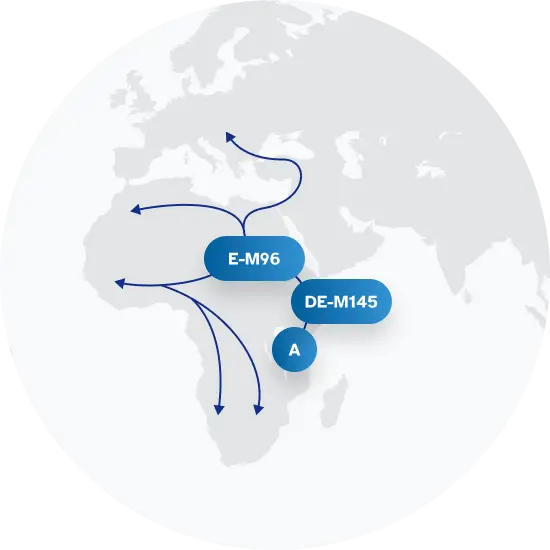Explore the Family Name Tarver
How common is the last name Tarver in the United States?
Based on data from the Decennial U.S. Census, the surname Tarver had a slight decrease in popularity between 2000 and 2010. In 2000, Tarver was ranked 3654th in popularity, but dropped to 3788th in 2010, marking a decrease of 3.67%. However, the count of individuals with this surname increased by 4.54%, from 8935 in 2000 to 9341 in 2010. This resulted in a slight decrease in the proportion per 100k from 3.31 to 3.17.
| 2000 | 2010 | Change | |
|---|---|---|---|
| Rank | #3,654 | #3,788 | -3.67% |
| Count | 8,935 | 9,341 | 4.54% |
| Proportion per 100k | 3.31 | 3.17 | -4.23% |
Race and Ethnicity of people with the last name Tarver
Regarding ethnicity, the Decennial U.S. Census data shows that there were several shifts in the ethnic identity associated with the surname Tarver between 2000 and 2010. The largest increase was found among those identifying as Asian/Pacific Islander, which saw an increase of 89.47%, although these numbers are still relatively small. Those identifying as Hispanic also saw a substantial increase of 71.11%. The number of individuals identifying as two or more races rose by 37.97%, while American Indian and Alaskan Native identities increased by 36.67%. In contrast, there was a small decrease in those identifying as White (-4.07%). The proportion identifying as Black remained stable, with a slight increase of 0.10%.
| 2000 | 2010 | Change | |
|---|---|---|---|
| Black | 49.94% | 49.99% | 0.1% |
| White | 46.64% | 44.74% | -4.07% |
| Hispanic | 1.35% | 2.31% | 71.11% |
| Two or More Races | 1.58% | 2.18% | 37.97% |
| American Indian and Alaskan Native | 0.3% | 0.41% | 36.67% |
| Asian/Pacific Islander | 0.19% | 0.36% | 89.47% |
Tarver ancestry composition
23andMe computes an ancestry breakdown for each customer. People may have ancestry from just one population or they may have ancestry from several populations. The most commonly-observed ancestry found in people with the surname Tarver is British & Irish, which comprises 49.4% of all ancestry found in people with the surname. The next two most common ancestries are French & German (17.8%) and Nigerian (9.2%). Additional ancestries include Ghanaian, Liberian & Sierra Leonean, Angolan & Congolese, Scandinavian, Spanish & Portuguese, and Eastern European.
Ready to learn more about your ancestry? Get the most comprehensive ancestry breakdown on the market by taking our DNA test. Shop 23andMe
| ANCESTRY BREAKDOWN | COMPOSITION |
|---|---|
| British & Irish | 49.4% |
| French & German | 17.8% |
| Nigerian | 9.2% |
| Other | 23.6% |

Possible origins of the surname Tarver
Your DNA provides clues about where your recent ancestors may have lived. Having many distant relatives in the same location suggests that you may all share common ancestry there. Locations with many distant relatives can also be places where people have migrated recently, such as large cities. If a large number of individuals who share your surname have distant relatives in a specific area, it could indicate a connection between your surname and that location, stemming from either recent ancestral ties or migration.
Based on 23andMe data, people with last name Tarver have recent ancestry locations all within the United Kingdom of Great Britain and Northern Ireland.
| RECENT ANCESTRY Location | Percentage |
|---|---|
| West Midlands, United Kingdom | 73.20% |
| Merseyside, United Kingdom | 73.20% |
| Greater London, United Kingdom | 73.20% |
| Lancashire, United Kingdom | 72.50% |
| Greater Manchester, United Kingdom | 72.50% |
What Tarver haplogroups can tell you
Haplogroups are genetic population groups that share a common ancestor on either your paternal or maternal line. These paternal and maternal haplogroups shed light on your genetic ancestry and help tell the story of your family.
The top paternal haplogroup of people with the surname Tarver is E-V13, which is predominantly found among people with European ancestry. Haplogroup E-V13 is descended from haplogroup E-M96. Other common haplogroups include E-M180 and R-P312, which are predominantly found among people with Sub-Saharan African and European ancestry. Other surnames with similar common haplogroups are: Goodrich, Epperson, Blevins, Groff, Grantham, Lanier, East, Babcock, Satterfield, Etter.
The most common maternal haplogroups of people with Tarver surname are: H1, N, H. These most commonly trace back to individuals of European ancestry.
 Paternal Haplogroup Origins E-M96
Paternal Haplogroup Origins E-M96
Your paternal lineage may be linked to early Balkan migrants
Haplogroup E1b1b1a1b1a migrated in large numbers from the Balkans into Europe about 4,500 years ago, triggered by the beginning of the Balkan Bronze Age. During this migration, members of haplogroup E1b1b1a1b1a mainly followed rivers connecting the southern Balkans to northern-central Europe. Technological leaps often cause lineages to grow dramatically in numbers and in geographic range. The development of Bronze technology may have given men in haplogroup E1b1b1a1b1a a competitive advantage over other men, causing haplogroup E1b1b1a1b1a to proliferate and become widespread.
Your maternal lineage may be linked to Marie Antoinette
Because it is so dominant in the general European population, haplogroup H also appears quite frequently in the continent's royal houses. Marie Antoinette, an Austrian Hapsburg who married into the French royal family, inherited the haplogroup from her maternal ancestors. So did Prince Philip, Duke of Edinburgh, whose recorded genealogy traces his female line to Bavaria. Scientists also discovered that famed 16th century astronomer Nicolaus Copernicus traced his maternal lineages to haplogroup H.

What do people with the surname Tarver have in common?
Spoiler alert: it's complicated. People with the same last name are usually no more genetically similar than a randomly sampled group of people from the same population. That said, people with the same surname are more likely to have similar ancestries than randomly sampled individuals. The reason is the tendency of people with similar cultural or geographical backgrounds to preferentially mate with one another. That's why people who share a surname may be more likely to share traits and tendencies in common than people within the general population. Check out the percentages below to see the prevalences of tastes, habits, and traits of people with your surname compared with prevalences among 23andMe users.
Preferences
Traits
Habits
Wellness

Migraine
A severe headache characterized by intense pain, sensitivity to light and sound, and often accompanied by nausea and vomiting.
"Tarver" Surname 16.8%
23andMe Users 16.4%
Are health conditions linked to the last name Tarver?
The short answer is that, if there is an association between surname and health, it's usually more about your ancestry than your name. Individuals with a given surname are no more genetically similar than the general population but often have similar ancestries. The populations of people associated with those shared ancestries often have sets of genetic variations, also known as alleles, in common. Some of those alleles are associated with a greater likelihood of developing certain diseases.
Disease variant frequency by ancestry
Disease allele frequencies in populations associated with the surname Tarver are shown below. Important Note: not everyone with a disease allele will develop these health condition
















